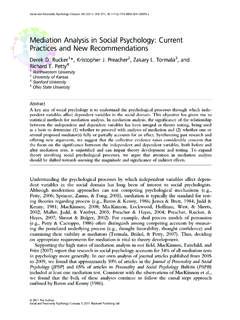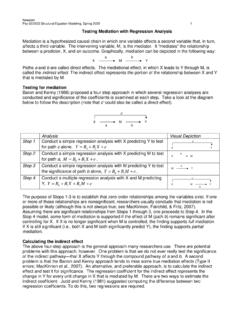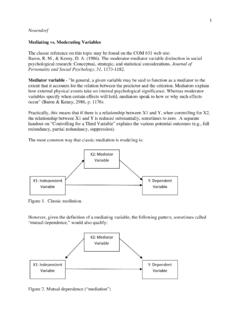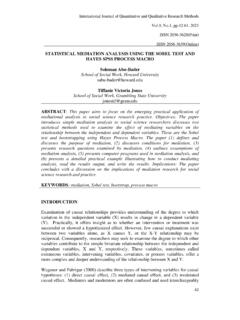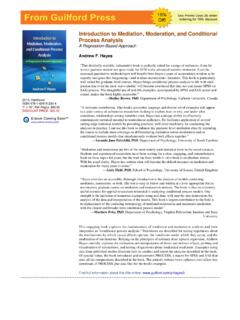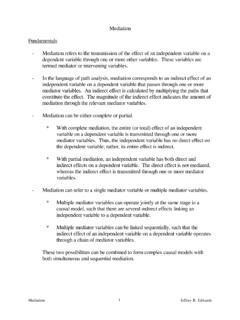Transcription of Structural Equation Modeling of Mediation and Moderation ...
1 CHAPTER NINES tructural Equation Modeling of Mediationand Moderation With Contextual FactorsTodd D. LittleUniversity of KansasNoel A. CardUniversity of ArizonaJames A. BovairdUniversity of Nebraska-LincolnKristopher J. PreacherChristian S. CrandallUniversity of KansasResearchers often grapple with the idea that an observed relationship may bepart of a more complex chain of effects. These complex relationships are de-scribed in terms such as indirect influences, distal vs. proximal causes, interme-diate outcomes, and ultimate causes; all of which share the concept , researchers must often consider that an observed relationship may bepart of a more complex, qualified system. These relationships are describedusing concepts such as interactions, subgroup differences, and shocks; all ofwhich share the concept ofmoderation. Generally speaking, a mediator can bethought of as the carrier or transporter of information along the causal chainof effects.
2 A moderator, on the other hand, is the changer of a relationship this chapter, we explore both empirical and theoretical considerations inmodeling Mediation and Moderation using Structural Equation Modeling . Our207208 LITTLE ET focus is on how to model contextual factors that are measured ascontinuous latent variables, highlighting the power of SEM to represent andtest these types of influence (see Little, Card, Slegers, & Ledford, chap. 6, thisvolume, for a discussion of moderating contextual factors that are measured ascategorical variables).MEDIATIONC ontextual factors can be conceptualized as mediated influences where the con-textual information is deemed to be a distal causal influence. For example, earlyprenatal conditions can influence cortical development, which in turn can in-fluence later intellective functioning (see Widaman, chap. 17, this volume).Contextual factors can also be conceptualized as the mediating influence wherethe contextual information is deemed to carry the distal causal example, children s temperament characteristics may influence the overallclassroom environment, which in turn may influence the quality of learning orschool well-being of the our discussion of Mediation , we use the standard convention ofreferring to the exogenous causal influence asX.
3 The endogenous causal influ-ence, or mediator, is referred to asM, and the dependent variable or outcomeis referred to Conditions for MediationBaron and Kenny s (1986) influential paperon Mediation analyses stated threenecessary but not sufficient conditions that must be met in order to claim thatmediation is occurring (but see Kenny, Kashy, & Bolger, 1998; MacKinnon,Lockwood, Hoffman, West, & Sheets, 2002). significantly related significantly related relationship ofXtoYdiminishes whenMis in the other words, each of the three constructs must show evidence of a nonzeromonotonic association with each other, and the relationship ofXtoYmustdecrease substantially upon addingMas a predictor ofY(for a review andcomparison of methods of testing Mediation , see MacKinnon et al., 2002).1 The1 Typically, these associations are adequately captured as linear relationships. Although itis beyond the scope of the current discussion, nonlinear Modeling can also be employed fortesting nonlinear Mediation AND MODERATION209regression weight ofYregressed onXis sometimes a Mediation analysis is the nature of the correlational structure among theset of three variables.
4 For example, if theX-to-Mlink (denoteda) correspondsto a .8 correlation and theM-to-Ylink (denotedb) also corresponds to a .8correlation, the implied correlation betweenXandYis .64 ( , in standard-ized metric: .8 .8), assuming the relationship ofXtoYcontrolling forMis zero. When this correlational structure is observed in the data, a mediationanalysis will provide support for Mediation (in this case, full Mediation , seethe following). If the observed correlation is larger than that implied by theproduct of the two pathways (aandb) then a direct positive effect ofXtoY(denotedc ) may be needed, depending on the magnitude of the deviation fromthe model implied correlation. On the other hand, if the observed correlation issmaller than the correlation implied by the product of the two pathways (aandb) then a direct negative value ofc may be needed, depending on the magni-tude of the deviation from the model implied correlation, andsuppressionis inevidence.
5 In other words, the empirical need for a direct pathway fromXtoYis driven by the magnitude and direction of the deviation of the observed fromthe implied correlation betweenXandYwhen thec path is not representedin the model. Table 1 depicts three idealized correlation patterns that wouldbe consistent with full Mediation , partial Mediation , and partial these variations on the kinds of Mediation that can emerge in a medi-ation analysis are intuitively appealing, they do not necessarily do justice to amore complete understanding of Mediation effects. Briefly we describe the con-cepts as typically found in the current literature, but then turn to a discussionof why these distinctions are unsatisfying the relationship between constructXand constructYisfully mediated,then all of the significant variance of that relationship will be accounted for bythe direct effect from constructMto constructY(b). That is, the influenceTABLE Correlational Structures That Would be Consistent With Full Mediation , PartialMediation, and High levels of intercorrelation are depicted below the diagonal and low levels of inter-correlation are depicted above the ET of In these idealized models, the correlations among all three constituents are assumed tobe positive in sign and significant.
6 All paths are positive except where noted in Panel C. indicates relative strengths of constructYis adequately captured as an indirect influence throughM(see Figure , Panel A) and the observed association betweenXandYisaccurately captured by tracing the pathways fromYback toM(b)andfromMback toX(a). (See , Loehlin, 1987, for a discussion of Wright s tracingrules; and see Table )Apartially mediatedrelationship is indicated if the direct effect of the me-diator construct,M, accounts for a significant amount of variance inY, butc remains significant. Ifc remains significant but differs in sign from the zero-order correlation betweenXandY, then Mediation with suppression is evident(see Figure , Panel C). In other words, ifc differs in sign from the prod-uct ofaandb( , one is a positive effect while the other is negative) oneMODELING Mediation AND MODERATION211interpretation would be thatXcontains two sources of variance that reflecttwo opposing channels by which it interpretations woulddepend on the signs of the various pathways and the composition of the variousconstructs.
7 More specifically, one channel would influenceYvia the indirectpathway of the mediator,M, while the other channel would influenceYinthe opposite direction once the influence ofMis accounted for thisregard, bothc andbwould need to remain significant when they are both inthe model (see Figure , Panel C; and see Table 1). For more information onsuppression and its relationship to Mediation , consult MacKinnon, Krull, andLockwood (2000).Finally, ifbis nonsignificant whenc is present in the model, then no me-diation is evident (see Figure , Panel D). Other patterns of associations arealso consistent with a lack of Mediation . For example, ifais not significantandbis significant, thebpathway would be interpreted as a covariate and nota mediator. Similarly, ifa,b,andc are all nonsignificant then no mediationwould be Notes of Caution. Despite the pervasiveness of terms like full andpartial Mediation , we caution against their landpartialare essentiallyinformal effect size descriptors.
8 They are intended to capture and communicatethe magnitude or importance of a Mediation effect, yet they are traditionallydefined in terms of statistical significance. In other words, an effect is termedpartialorcompletebased not only on the strength of the effect, but also onthep-values associated withcandc , and hence on sample size. Traditionally,statistical significance and practical significance are separate concepts, and thelatter should not negative consequence of usingp-values to define effect size is that somecircumstances are likely to lead to conclusions of full Mediation that shouldmore intuitively be considered partial Mediation . In other words, there existsthe danger of unwittingly exaggerating the size or importance of an effect. Forexample, given that an indirect effect is statistically significant, the smaller thesample is, the more likely we are to conclude that the total effect ofXonYis fully mediated because the standard error ofc increases asNdecreases.
9 Inother words, the researcher is rewarded with apparently more extensive medi-ation the smallerNbecomes, but no one would seriously advocate using smallsamples to achieve large apparent effectsizes. A second negative consequenceis that the smaller the total effect (c) is, the more likely one is to demonstratefull Mediation ; restated, the smaller an effect is, the easier it is to fully mediateit. A consequence of this is that the less reliable one sXandYvariables are,the more likely one is to achieve full Mediation . It can be misleading to claimthat an inconsequential but statistically significant effect is fully mediated. Finally, full Mediation can never logically exist in the population because it212 LITTLE ET a regression weight to be exactly equal to zero. The probability of thisoccurring in practice is zero. Findingc =0andc not significantly differentfrom zero are two very different things; with the latter, all the researcher canclaim is that there is not enough evidence to reject the hypothesis of full media-tion (but given a largerN, we almost certainly would).
10 We recommend insteadinvestigating the statistical significance of the Mediation effect andseparatelyconsidering whether or not the effect ispractically important or constitutes a practically meaningful effect will vary from context to con-text, and relies on the scientist s judgment and background knowledge. In whatfollows, we examine some methods that can be used to establish the statisticalsignificance of a Mediation Considerations in Testing for consideration for findingsupport for Mediation is whether the indirect pathway fromXtoMtoY(a b)is statistically significant (Shrout & Bolger, 2002). All major SEM programsprovide estimates of indirect effects andtheir associated standard errors whichare used to determine the significance ofthe effect by way of the Wald statistic( , an estimate divided by its standard error provides a large-sampleZ-valueto gauge the statistical significance of the effect).
